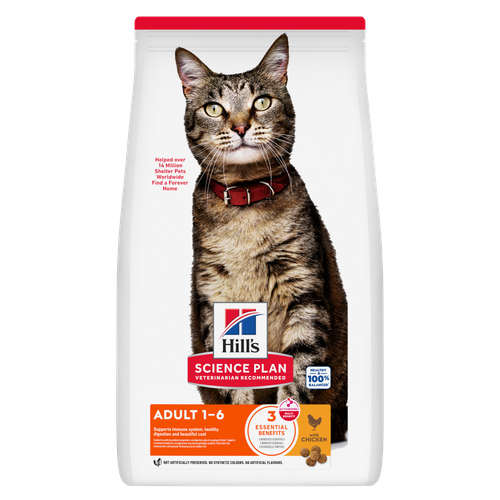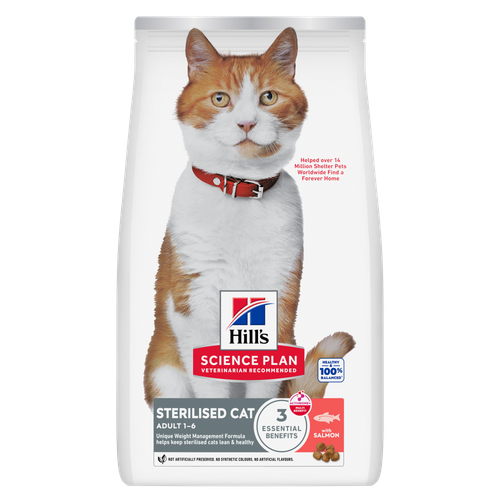
-
Find the right food for your petTake this quiz to see which food may be the best for your furry friend.Find the right food for your petTake this quiz to see which food may be the best for your furry friend.Featured products
 Perfect Digestion Large Breed Puppy Food
Perfect Digestion Large Breed Puppy FoodPrecisely balanced nutrition with Hill's ActivBiome+ prebiotic blend actively contributes to supporting digestive health and overall wellbeing to help your pet feel their best
Shop Now Large Breed Adult Dog Food
Large Breed Adult Dog FoodHill's Science Plan Large Breed Adult Dog Food with Lamb & Rice is a complete pet food, specially formulated with ActivBiome+ Multi-Benefit Technology.
This food is specifically designed to fuel the energy needs of large breed dogs during the prime of their life.Shop Now Adult Light Dog Food
Adult Light Dog FoodHill's Science Plan Light Adult Wet Dog Food is a complete premium pet food for adult dogs that tend to gain weight easily. This deliciously smooth loaf is formulated to deliver the appropriate amount of energy to support weight maintenance in adult dogs.
Shop NowFeatured products Adult Cat Food
Adult Cat FoodHill's Science Plan Adult Cat Food with Chicken is a complete pet food, specially formulated with ActivBiome+ Multi-Benefit Technology.
This food is specially formulated to fuel the energy needs of cats during the prime of their life.Shop Now CULINARY CREATIONS ADULT CAT FOOD
CULINARY CREATIONS ADULT CAT FOODHill's Science Plan CULINARY CREATIONS Adult cat food with Salmon & Carrots was formulated to provide a great-tasting experience to cats. Its delicious flavour and texture are combine with essential nutrients to support cats' optimal health during the prime time of their life. Specially formulated with high-quality salmon protein, essential taurine for heart health & balanced minerals to support kidneys & bladder.
Shop Now Sterilised Adult Cat Food
Sterilised Adult Cat FoodHill's Science Plan Adult Sterilised Cat Dry Food with Salmon is specially formulated with ActivBiome+ Multi-Benefit Technology. It is a precisely balanced nutrition, tailored to meet the needs of sterilised cats, to help keep sthem lean & healthy.
Shop Now -
Dog
- Dog Tips & Articles
-
Health Category
- Weight
- Food & Environmental Sensitivities
- Urinary
- Digestive
- Joint
- Kidney
-
Life Stage
- Puppy Nutrition
- Adult Nutrition
- Senior Nutrition
Cat- Cat Tips & Articles
-
Health Category
- Weight
- Skin & Food Sensitivities
- Urinary
- Digestive
- Kidney
-
Life Stage
- Kitten Nutrition
- Adult Nutrition
Featured articles The Incredible Science Behind Your Pet's Microbiome
The Incredible Science Behind Your Pet's MicrobiomeLearn what your pet's microbiome is, how it contributes to your pet's gut and overall health, and why nutrition is important in maintaining healthy microbiomes.
Read More Pet Nutrition: What Makes "Healthy" Pet Food Healthy? | Hill's Pet
Pet Nutrition: What Makes "Healthy" Pet Food Healthy? | Hill's PetIn people, the right diet is very important. If you are eating the wrong way for your metabolism, activity level, age and lifestyle you could end up with health issues.
Read More Microchipping: The Facts | Hill's Pet
Microchipping: The Facts | Hill's PetThe government has announced that as of April 2016, all dogs in the UK must be microchipped by law.
Read More -


You may catch your cat licking her paws or chewing on herself from time to time. Why do cats clean themselves? Self-grooming is a trademark characteristic of most cats that begins right after birth. Mothers lick their kittens to clean them, provoke urination and suckling, provide comfort, and strengthen their bond. At 4 weeks of age, kittens begin grooming themselves, and shortly thereafter start grooming their mother and littermates. This self-grooming and mutual grooming (referred to as allogrooming) continues into adulthood.

All the right parts
Cats are flexible, strategic, and well-equipped for grooming. Everything from the rough surface of a cat's tongue to her sharp teeth, comb-like paws, and forepaws add up to a finely tuned grooming machine. A cat can even use her front paws to stimulate tiny oil glands on her head. The oil is a cat's "perfume" and is spread all over the body.
Why do cats groom?
Cats groom themselves not only to keep clean, but for several other health reasons:
- To regulate body temperature
- To keep her coat clean and smooth by distributing natural skin oils
- To stimulate circulation
- To cool herself down through evaporation of saliva
- To eliminate parasites, infection, and allergies
- To prevent hairballs (Click here for more about dealing with cat hairball problems)
- Displacement behavior: If your cat feels embarrassed, anxious, or as though she’s in a conflict, she may lick to calm herself.


Tasty Tips
Compulsive grooming
Does your cat seem to be licking, biting, or nibbling herself incessantly? Keep in mind that most cats spend between 30 and 50 percent of their day grooming themselves. But if you start to notice obsessive grooming, hair loss, or skin lesions, it may be time for a visit to the vet.
Compulsive grooming may be the result of a medical condition. It could indicate a neurological disorder, flea infestation, parasites, or a psychological disorder. Stress often causes cats to develop compulsive disorders like excessive grooming early in life. Events like moving, home remodeling, a new pet or family member, separation anxiety, and lack of stimulation can trigger these behaviors. And because self-grooming soothes and calms your cat, she will want to do it every time she’s faced with a conflict. If the behavior is not addressed, it can result in self-inflicted injury. For instance, psychogenic alopecia, or fur plucking, is a common condition that includes hair thinning, balding, and skin infections.
Under-grooming
Regular self-grooming will help your cat look good and feel good, but if she becomes ill, she may stop cleaning herself. This could be a sign of arthritis, pain, or dental problems. Cats who are taken away from their mothers too early may also not know how to properly clean themselves.
Watch for these warning signs of under-grooming:
- A harsh or greasy coat
- Small mats of fur on her body or tail
- Staining on the paws from urine or residue
- Foul smell
- Food particles on her face or chest after meals
To encourage your cat to begin grooming, start by brushing her daily. Brushing stimulates the skin and blood circulation, and rids her of fleas and ticks. When she starts grooming, try not to interrupt her. It’s important for your cat, so let her make the most of it.


One of our staff authors prepared this article for you
Related products

Hill's Science Plan Adult Cat Food with Chicken is a complete pet food, specially formulated with ActivBiome+ Multi-Benefit Technology.
This food is specially formulated to fuel the energy needs of cats during the prime of their life.

Hill's Science Plan CULINARY CREATIONS Adult cat food with Salmon & Carrots was formulated to provide a great-tasting experience to cats. Its delicious flavour and texture are combine with essential nutrients to support cats' optimal health during the prime time of their life. Specially formulated with high-quality salmon protein, essential taurine for heart health & balanced minerals to support kidneys & bladder.

Hill's Science Plan Adult Sterilised Cat Dry Food with Salmon is specially formulated with ActivBiome+ Multi-Benefit Technology. It is a precisely balanced nutrition, tailored to meet the needs of sterilised cats, to help keep sthem lean & healthy.

Hill's Science Plan Senior Vitality Cat Food with Chicken & Rice provides precisely balanced nutrition that helps promote their everyday ability to get up and go.
Related articles

Learn how your cat's poo can be a good indicator of her overall health, including how to spot unhealthy or abnormal cat poop and what it might mean.

Learn about the causes of cat dermatitis, how to spot the symptoms and the best treatment options. Visit Hill's Pet for detailed guidance and tips.

Cats with sensitive skin have special needs and even healthy cats can sometimes develop poor skin health. Learn more about sensitive skin symptoms in your cat, what you can do to help your pet feel more comfortable and get recommendations on sensitive skin cat food.

Understand common skin issues in cats and how to manage them effectively. Learn signs and prevention, and get care tips. Find out more at Hill's Pet.

Put your cat on a diet without them knowing
Our low calorie formula helps you control your cat's weight. It's packed with high-quality protein for building lean muscles, and made with purposeful ingredients for a flavourful, nutritious meal. Clinically proven antioxidants, Vitamin C+E, help promote a healthy immune system.
Put your cat on a diet without them knowing
Our low calorie formula helps you control your cat's weight. It's packed with high-quality protein for building lean muscles, and made with purposeful ingredients for a flavourful, nutritious meal. Clinically proven antioxidants, Vitamin C+E, help promote a healthy immune system.

